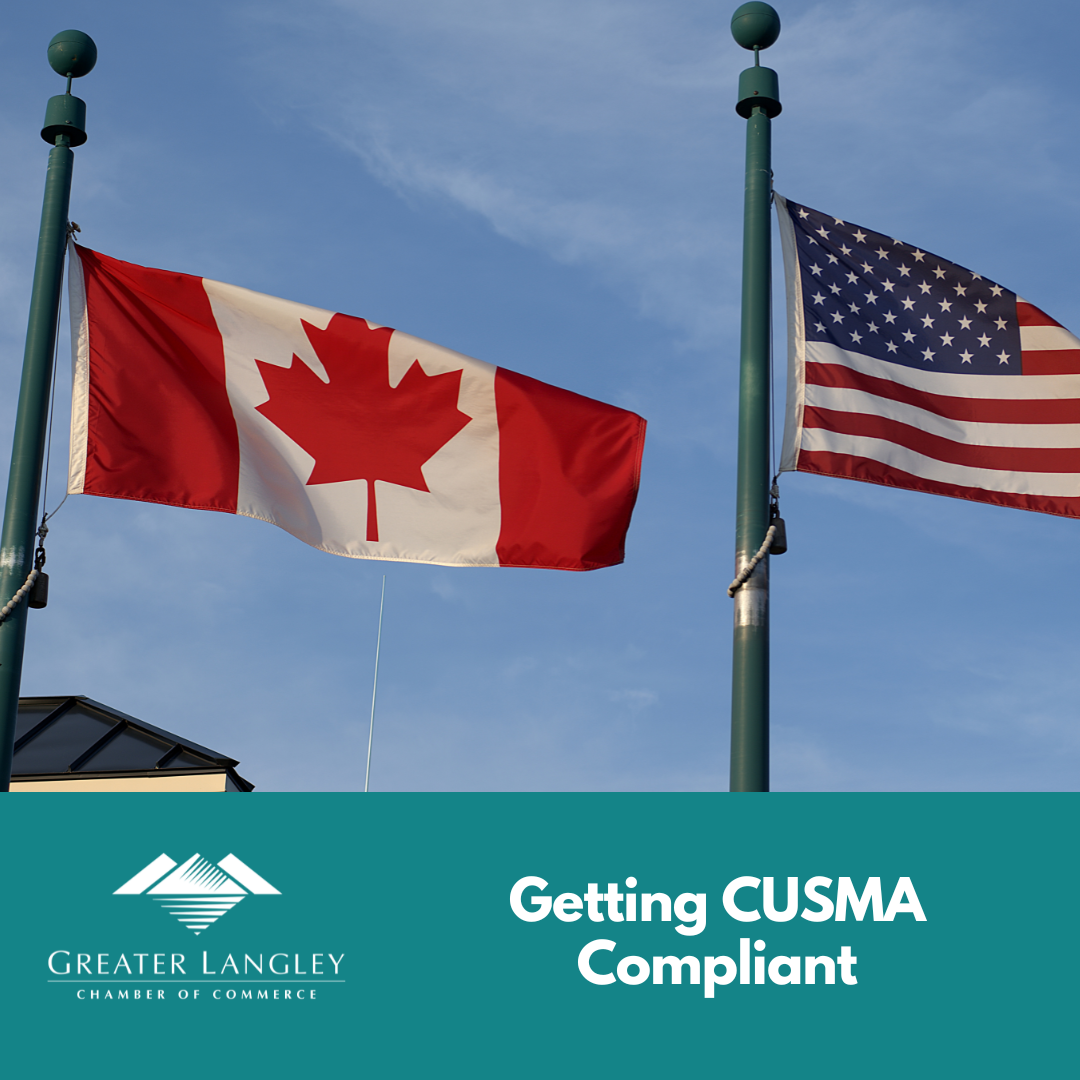Getting CUSMA Compliant
Getting CUSMA Compliant

Canadian businesses exporting to the US have received some relief from US tariffs if they are exporting goods that are deemed "CUSMA-compliant." Being CUSMA compliant means that goods meet the CUSMA rules of origin and qualify for preferential tariff treatment under the trade deal, which is also sometimes called the USMCA or "new NAFTA". Goods exported under CUSMA are exempt from the 35% tariffs that apply to non-compliant goods from Canada. However, to avoid these 35% tariffs, exporters must certify that their goods are CUSMA compliant and eligible for preferential treatment, and imports must then claim the tariff exemption.
Here’s what Langley businesses and exporters need to know, but note, the following is for information purposes only, the Langley Chamber assumes no responsibility for its use, and encourages exporters to seek professional advice:
CUSMA qualification isn’t automatic — Even if your product is made in Canada, you must prove it meets the CUSMA rules of origin. That means ensuring a certain amount of your product’s value, components, or processing occurred within North America. The importer into the US must then claim the preferential treatment to receive the tariff-free benefit.
Claiming the benefit requires some paperwork — Exporters (or their importers) must complete a certification of origin to access CUSMA’s duty-free treatment. Without this, your goods will be subject to the new U.S. tariffs — even if they would have previously entered tariff-free under Most-Favoured-Nation (MFN) terms. Either the importer, exporter, or manufacturer can fill out the certificate or origin. Typically, goods would be classified as either being wholly produced in Canada, made completely in Canada but have parts from somewhere else outside North America, or manufactured within North America using only North American components.
There is no one template to use -- it just needs to have the necessary information which includes:
- Importer: name, address (legal residence in country of import).
- Exporter: name, address (legal residence in country of export).
- Producer: name, address (legal residence in country of production)
- Certifier: name, address, contact details (who is completing the form).
- Description of goods: clear description; must match customs docs.
- HS Tariff Classification: at the 6-digit level (minimum).
- Origin Criteria: reference one of the CUSMA origin rules (A–D)
- A: Wholly obtained/produced in CUSMA countries (made, grown or produced in North America - ie: natural resources, crops and commodities)
- B: Produced in region using qualifying materials (made in North America, but has some parts from somewhere else)
- C: Produced entirely from originating materials (made in North America with North American components)
- D: Special provisions (auto, textiles, etc.)
- Blanket period (if applicable): may cover multiple shipments of identical goods for up to 12 months
- Authorized signature & certification statement: must be signed/date by the certifier, declaring that the information is correct.
Read this walkthrough on how to fill out a Certificate of Origin >
See this step-by-step of how to create a Certificate of Origin by Canada Border Services >
Watch this video from Chamber member Pacific Customs Broker on filling out a CUSMA certificate of origin >
Knowing if your goods qualify - Certain goods (e.g., vegetables harvested in Canada or minerals mined in Canada) must be wholly-obtained in Canada. Other goods can be manufactured using some imported materials, if they undergo enough work to qualify as "originating" in Canada. Typically, this would mean either:
- the final good's classification is different than its inputs (ie: a manufacturer could import oak wood to make a kitchen table under CUSMA, as the classification for the table is different enough from the raw material)
- a certain percentage of the value of the final good is added to it in North America
- the good undergoes a certain process in North America (ie: a shirt must be "cut and sewn" in North America to comply with CUSMA)
Use the right classification — All goods are subject to product-specific rules based on their Harmonized System (HS) code. Understanding the exact HS classification of your product is key to knowing what rules apply. Use the Tariff Finder to help identify your HS classification code >
Keep evidence and be ready to prove it - Keep all documentation supporting the origin for at least 6 years after the exportation of the good. Traders may be audited by CBSA (for imports into Canada) or U.S. CBP (for imports into the U.S).
Suggested documents to keep include:
- Certifications of origin
- Purchase orders
- Bills of materials
- Supplier declarations
- Costing and production records
- All documents that relate to the export of goods
This matters even if your tariffs were zero before — Many Canadian businesses never formally claimed CUSMA benefits because MFN tariffs were already low or zero. But that approach no longer works under the new U.S. tariff regime — you must actively claim CUSMA treatment to avoid duties.
If you’re unsure whether your goods qualify or how to properly claim preferential treatment, consulting with a customs broker is strongly recommended. Find a local logistics/customs company >
There is up to $5000 in funding available to help cover the costs of getting CUSMA compliant. Learn more here >
For help navigating tariffs, you can also seek support from Canada's Trade Commissioner Service. Contact them by email or call their support line at 1‑833‑760‑1167.
For more more resources or assistance, visit our Tariff Toolkit at LangleyChamber.com/Tariffs >
